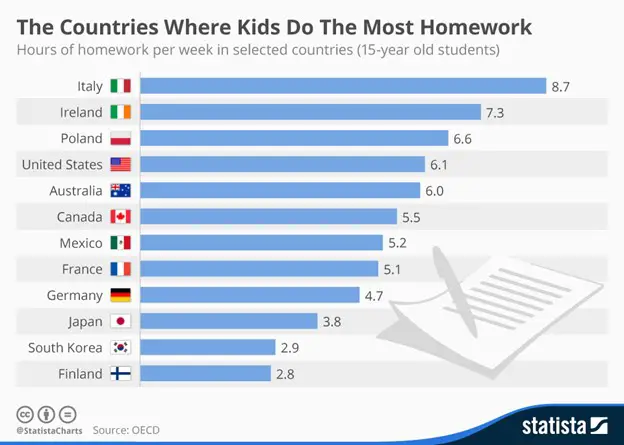High school can feel overwhelming at times. There are multiple teachers, subjects, and learning objectives to be completed at the same time. All this coordination results in high school teachers giving students homework that can quickly pile up. This leaves students to ask: “why do high school teachers give so much homework?”
The main reason why high school teachers give students homework is so they can revise or complete the learning covered in class. Moreover, homework is beneficial as it highlights the value of responsibility and time-management skills. Sometimes homework becomes too much when different teachers assign tasks simultaneously, or multiple tests are approaching.
Teachers are under pressure from administrators and school districts to cover the curriculum content and show academic progress. So, if students struggle with or do not meet learning objectives for whatever reason, a teacher will often assign the work to be completed at home. Either this or the teacher will hold students after the bell for extra studying.
Another reason why high school teachers assign homework is to help students become independent learners and prepare them for higher education.
Important skills are practiced when students stay on top of homework tasks and deadlines. For instance, students train and develop being responsible and how to manage their time effectively.
Nevertheless, when assigned too much homework, studies have pointed to consequences such as mental health problems and physical ailments. The news report below highlights this point.
The rest of this article will discuss how much homework teachers should assign and how to manage the workload.
How Much Homework Should High School Teachers Give?
A high school teacher should give around 10-20 minutes of clear, purposeful homework per night. This number is ideal considering that multiple other teachers are potentially giving homework as well, so a student is likely to spend between 60-90 minutes per night on homework in total.
Homework serves an important function. But it can also be counterproductive when too much homework is assigned. Several studies suggest that the optimal amount of time high school students should spend on homework is between 60-90 minutes per night.
High school teachers should also be aware of what the other teachers in the grade are assigning to ensure the work is manageable.
Some schools develop a homework policy that dictates how much or little homework is assigned per grade. For instance, some schools don’t assign homework other than catch-up work or projects, while others may set a homework sheet every night.
Regardless of the policy, teachers must consider their students’ needs and homework goals before setting assignments. It is also essential that teachers coordinate with their colleagues to ensure that, cumulatively, the homework assignments are still manageable for students.
It should be emphasized that a higher number of hours spent doing homework does not necessarily result in better academic outcomes.
The chart below shows how 15-year-olds in South Korea and Finland spend less time on homework than their counterparts in Italy and the United States. Yet, South Korea and Finland regularly rank highly on global educational standards.

Types of Homework That School Teachers Should Assign
On top of a homework policy, high school teachers must ensure their homework is purposeful, easy to understand, and does not require special instruction.
The reason for such qualifications is that students have different learning styles and abilities.
A homework assignment that takes one student ten minutes to complete might take another student longer than that based on individual differences. Some may need more in-person instruction and support with work, which can’t necessarily be given when a student completes their work at home.
So, the students should have a clear understanding of what to do. That way, they can complete their assignments independently to the best of their ability at home without any intervention from others.
Additionally, educators should be aware that not all students have access to the same devices or resources. So, any assigned homework should be accessible to all students through the delivery means of the teacher. In other words, the teacher should try to give physical copies of work to students versus relying on them to print any work at home.
How To Manage Homework Assignments
Helping students prepare to manage their homework assignments is vital to ensure their success when completing them.
It can be easy for some to get distracted or forgetful with schoolwork, so homework management should be facilitated by the teacher and maintained by the student.
Many elementary schools offer agendas and homework booklets to their students, and this practice sometimes continues into high school. Each institution has its own way of helping students manage work, with many turning to virtual school communication apps that can be downloaded onto smartphones.
Virtual School Organization Apps
Seesaw and myHomework Student Planner are examples of the virtual school planner apps that some teachers, parents, and students use to maintain communication and organization.
These apps are now commonly used, especially since online learning has become more prominent recently. The apps are helpful as they do what they set out to do – organize work.
Digital platforms are also more engaging for students, which will help motivate them to complete and submit tasks on time.
However, they can’t always be relied upon because not all students have access to smartphones, internet access, or computers at home, so virtual homework apps may not be the best option for all students.
Other Organization Tools
As an educator, my experience is that virtual apps offer efficiency but lack full accessibility for students. So, I prefer to stick to hard copy tools used to help high school students organize their schoolwork.
While agendas and journals may be more geared toward elementary school students, they’re much more practical for high school students with a legitimate workload.
High school students have multiple subjects to learn in a semester, requiring significantly more effort. So, agendas are hard copy tools that can play a critical role in helping students organize and maintain their schoolwork.
Schools design and print agendas for their students. You can purchase these agendas through the school administration for the most part (some schools may offer them for free).
Otherwise, you can also use simple day planners like the Global Printed Products Hardcover 2023 Planner or the Productivity Store Daily, Weekly, and Monthly Day Planner (both available on Amazon.com). These day planners have well-designed layouts for students to help them stay organized.
Final Thoughts
High school teachers give homework to reconsolidate or complete the learning covered in class. If every high school teacher assigned a homework task, then the accumulation of homework can become overwhelming for students.
Teachers should be mindful of this and limit the homework they set to around 10-20 minutes. They should also collaborate with other faculty members to ensure consistency across the school and that students’ well-being is prioritized.
High school educators should also work closely with students to help them manage and organize tasks more effectively. Digital platforms like Google Classroom or conventional methods like an agenda are recommended.
Finally, homework should always be purposeful and clear otherwise students will not see the benefits and become disengaged with the learning.
For further information on the main points mentioned in this article, check out this video:
Sources
- Edutopia: What’s the right amount of homework?
- Edutopia: Homework vs. No Homework
- NEA: How much homework is too much?
- Statista: The Countries Where Kids Do The Most Homework
- YouTube: Above the Noise – Is Homework Necessary?
- EurekAlert: How much math, science homework is too much?
- YouTube: CBS New York – Can Too Much Homework Harm Your Child’s Health?


